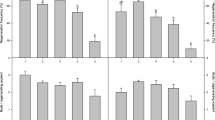Abstract
Cotyledonary-stage embryos of Haifa white clover, collected 13 days after cross-pollination, were induced to form adventitious shoots primarily from the hypocotyl region. The culture medium used for the production of adventitious shoots contained 5 μM thidiazuron and 0.5 μM α-naphthaleneacetic acid. Numerous shoot meristems were produced within the first week, discrete shoots developed by week three, small plantlets by week eight, and whole plants in soil by week ten. 95–100% of all embryos, regardless of genotype, produced adventitious shoots within four weeks with an average production of 17.5 shoots per embryo. The majority of shoots (on average 77%) were easily converted to whole plants in soil. The white clover regeneration system described is prolific, rapid and effective on a large number of genotypes.
Similar content being viewed by others
Abbreviations
- BA:
-
N6-benzylaminopurine
- MS medium:
-
Murashige & Skoog medium (1962)
- NAA:
-
α-naphthaleneacetic acid
- thidiazuron:
-
N-phenyl-N′-1,2,3-thiadiazol-5-ylurea
References
Ahuja PS, Lu DY, Cocking EC & Davey MR (1983) an assessment of the cultural capabilities of Trifolium repens L. (white clover) and Onobrychis viciifolia Scop. (sainfoin) mesophyll protoplasts. Plant Cell Rep. 2: 269–272
Bhojwani SS, Mullins K & Cohen D (1984) Intra-varietal variation for in vitro plant regeneration in the genus Trifolium. Euphytica 33: 915–921
Bhojwani SS & White DWR (1982) Mesophyll protoplasts of white clover: isolation, culture and organogenesis. Plant Sci. Lett. 26: 265–271
Bond JE & Webb KJ (1989) Regeneration and analysis of plants from stolon segments of Trifolium repens (white clover). Plant Sci. 61: 119–125
Gill R & Saxena PK (1992) Direct somatic embryogenesis and regeneration of plants from seedling explants of peanut (Arachis hypogaea): promotive role of thidiazuron. Can. J. Bot. 70: 1186–1192
Gresshoff PM (1980) In vitro culture of white clover: callus, suspension, protoplast culture, and plant regeneration. Bot. Gaz. 141(2): 157–164
Khan MRI, Tabe LM, Heath LC, Spencer D & Higgins TJV (1994) Agrobacterium-mediated transformation of subterranean clover (Trifolium subterraneum L.). Plant Physiol. 105: 81–88
Maheswaren G & Williams EG (1984) Direct somatic embryoid formation on immature embryos of Trifolium repens. T. pratense, and Medicago sativa, and rapid clonal propogation of T. repens. Ann. Bot. 54: 201–211
Malik KA & Saxena PK (1992) Regeneration in Phaseolus vulgaris L.: high-frequency induction of direct shoot formation in intact seedlings by N6-benzylaminopurine and thidiazuron. Planta 186: 384–389
Malik KA & Saxena PK (1992) Thidiazuron induces high-frequency shoot regeneration in intact seedlings of pea (Pisum sativum), chickpea (Cicer arietinum) and lentil (Lens culinaris). Aust. J. Plant Physiol. 19: 731–740
Mohamed MF, Read PE & Coyne DP (1992) Dark preconditioning, CPPU, and thidiazuron promote shoot organogenesis on seedling node explants of common and faba beans. J. Amer. Soc. Hort. Sci. 117(4): 668–672
Mok MC, Mok DWS, Armstrong DJ, Shudo K, Isogai Y & Okamoto T (1982) Cytokinin activity of N-phenyl-N′-1,2,3-thiadiazol-5-ylurea (thidiazuron). Phytochemistry 21,7: 1509–1511
Murashige T & Skoog F (1962) A revised medium for rapid growth and bioassays with tobacco tissue cultures. Physiol. Plant. 15: 473–497
Nugent G, Wardley-Richardson T & Lu C (1991) Plant regeneration from stem and petal of carnation (Dianthus caryophyllus L.). Plant Cell Rep. 10: 477–480
Oswald TH, Smith AE & Phillips DV (1977) Callus and plantlet regeneration from cell cultures of Ladino clover and soybean. Physiol. Plant. 39: 129–134
Parrott WA (1991) Auxin-stimulated somatic embryogenesis from immature cotyledons of white clover. Plant Cell Rep. 10: 17–21
Sriskandarajah S, Skirvin RM, Abu-Qaoud H & Korban SS (1990) Factors involved in shoot elongation and growth of adventitious and axillary shoots of three apple scion cultivars in vitro. J. Hort. Sci. 65: 113–121
Webb KJ, Woodcock S & Chamberlain DA (1987) Plant regeneration from protoplasts of Trifolium repens and Lotus corniculatus. Plant Breeding 98: 111–118
White DWR (1984) Plant regeneration from long-term suspension cultures of white clover. Planta 162: 1–7
White DWR & Voisey C (1994) Prolific direct plant regeneration from cotyledons of white clover. Plant Cell Rep. 13: 303–308
Weissinger AK & Parrott WA (1993) Repetitive somatic embryogenesis and plant recovery in white clover. Plant Cell Rep. 12: 125–128
Yamada T (1989) Selection of a highly-regenerative genotype of white clover (Trifolium repens L.) and plant regeneration from protoplasts derived from this genotype. Euphytica 44: 181–186
Author information
Authors and Affiliations
Rights and permissions
About this article
Cite this article
Beattie, L.D., Garrett, R.G. Adventitious shoot production from immature embryos of white clover. Plant Cell Tiss Organ Cult 42, 67–72 (1995). https://doi.org/10.1007/BF00037683
Received:
Accepted:
Issue Date:
DOI: https://doi.org/10.1007/BF00037683




